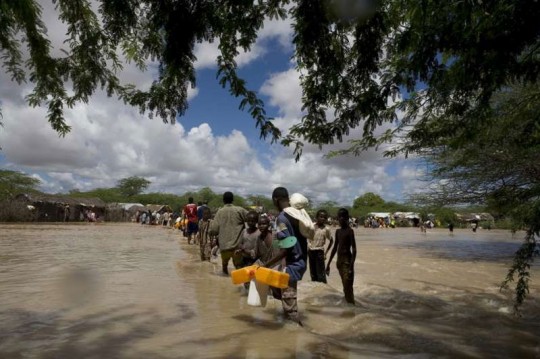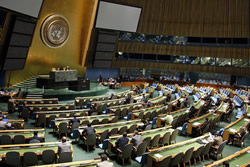UN agencies boost aid efforts to help Somalis hit by floods, famine and insecurity
UN agencies boost aid efforts to help Somalis hit by floods, famine and insecurity
4 November 2011
United Nations humanitarian agencies announced today that they are stepping up their support for Somalia as the country faces the combined impact of heavy rains, widespread famine and continuing insecurity in the streets.
 Displaced Somalis were affected by previous floods in November 2006, in Dadaab
Displaced Somalis were affected by previous floods in November 2006, in Dadaab
Thousands of displaced Somalis have been affected by downpours during the current rainy season in parts of Somalia, Kenya and Ethiopia, the United Nations refugee agency reported, adding that it is speeding up efforts to provide emergency assistance in refugee camps.
According to the UN High Commissioner for Refugees (UNHCR), the rains have flooded some 2,800 people in the Sigale camp in Mogadishu, disrupted the transport system and slowed the pace of internal displacement in the impoverished country.
UNHCR spokesperson Andrej Mahecic told a press briefing in Geneva that the agency has distributed 4,500 assistance kits so far, which include plastic sheets, plastic buckets and soap. He also said that despite the rains slowing down the movement of people, many continue to move away from areas of conflict.
“We are still seeing some movement. In the last week, more than 2,200 people have moved from Afgooye and Daynile, north of Mogadishu, to areas south of the capital in Banadir district. Some say they fled due to general insecurity, while others were trying to return to their home areas in anticipation of deteriorating security,” he said.
Drought and insecurity in Somalia has forced more than 330,000 people to flee the country this year, with the vast majority going to neighbouring Kenya, Ethiopia, Yemen and Djibouti.
In the Dadaab refugee complex in Kenya where some 5,000 people have lost their homes due to the flood waters, UNHCR and its partners have moved them to dryer parts of the camps, and provided blankets and sleeping mats while working to improve drainage in the flooded areas.
Mr. Mahecic also expressed concern for the increasing number of cases of flood-related illnesses in refugees.
“We are seeing a worrying rise in the number of watery diarrhoea cases and a general deterioration of the health situation among refugees, with some 600 people approaching the health centres daily. As part of efforts to prevent disease outbreak, we have started awareness campaigns to encourage refugees to wash their hands, boil water and drink only safe water,” he said.
In addition to providing emergency relief for floods, other UN agencies continue to increase their efforts to help Somalis who suffer from famine and insecurity.
The UN Children’s Fund (UNICEF) announced today that it is opening its first transit hub in the port of Dubai to accelerate the delivery of nutrition supplies to Somalia.
According to a news release issued by UNICEF, an estimated 5,000 tons of corn soya blend flour will be moved through the warehouse each month to the worst-affected regions of the country.
There are currently 1.5 million children in southern Somalia who are in dire need of humanitarian assistance, including some 190,000 who are severely malnourished and at high risk of death within weeks if they do not receive the necessary support.
“The humanitarian transit hub will make a major impact in widening our pipeline and also improving the predictability of supply delivery,” said Shanelle Hall, Director of UNICEF’s supply division. “It will help us ensure a regular flow of nutrition supplies for the worst-affected children and their families.”
Over 100 days have passed since famine in southern Somalia was formally declared. Since then a significant scale-up of relief activities have reached 2.2 million people, giving them access to food and water. Insecurity in the country however, has continued, increasing the number of weapons-related injuries and casualties.
During the press briefing, Tarik Jasarevic of the World Health Organization (WHO) said that according to health partners on the ground there were 70 injuries and 12 weapons-related deaths just last week due to fighting in the Lower Juba region, in addition to the 441 casualties that were treated in one hospital last month in Mogadishu. He added that WHO is responding by dispatching trauma kits for surgeries.
###
Heavy rains hit thousands of displaced Somalis in region
This is a summary of what was said by UNHCR spokesperson Andrej Mahečić – to whom quoted text may be attributed – at the press briefing, on 4 November 2011, at the Palais des Nations in Geneva.
Thousands of displaced Somalis have been affected by heavy rains and flooding in parts of Somalia, Kenya and Ethiopia.
In Somalia’s capital Mogadishu, the rains have flooded the shelters of some 2,800 people in Sigale IDP camp. In response, UNHCR has distributed 4,500 assistance kits with plastic sheets, supporting sticks, plastic buckets and soap. More distributions are planned for some of the worst-affected IDP camps.
Heavy downpours have also disrupted the transport system and slowed the pace of internal displacement in Somalia. Nonetheless, we are still seeing some movements. In the last week, more than 2,200 people have moved from Afgooye and Daynile north of Mogadishu, to areas south of the capital in Banadir district. Some say they fled due to general insecurity, while others were trying to return to their home areas in anticipation of deteriorating security.
In Kenya’s Dadaab refugee complex, some 5,000 refugees in the Ifo 2 East and West camps have lost their homes to the flood waters. UNHCR and partners have moved them to dryer parts of the camps, giving them blankets and sleeping mats while working to improve drainage in the flooded areas.
The rains have also hampered road access in some parts of the camp and damaged some latrines. We are seeing a worrying rise in the number of watery diarrhea cases and a general deterioration of the health situation among refugees, with some 600 people approaching the health centres daily. As part of efforts to prevent disease outbreak, we have started awareness campaigns to encourage refugees to wash their hands, boil water and drink only safe water.
Fewer refugees are arriving in Dadaab due to the rains and growing insecurity in the Kenya-Somalia border area. Monitoring teams have found some recent arrivals living with families in the camps.
In Ethiopia’s Dollo Ado area, there were more refugee arrivals last month than in the previous two months. With over 8,800 arrivals, October recorded the fourth-highest number of arrivals this year, after June, July and May. The recent arrivals mostly came in the first half of October, possibly fleeing food shortage and rising insecurity in Somalia’s Gedo area. In the last two weeks, rains and flooded roads have slowed these movements.
The four camps in Dollo Ado are now full. Construction of a fifth camp, Buramino, is expected to be completed in about two weeks. In the meantime, some 6,000 recent arrivals are temporarily living at the transit centre, where they receive shelter, food, water and health care.
So far this year, some 330,000 Somalis have fled drought and insecurity and sought refuge in the neighbouring countries of Kenya, Ethiopia, Yemen and Djibouti. While the recent rains in parts of the region may bring some relief to drought-hit areas, it is unlikely to ease the famine unless farming activities can resume in an improved security climate.
###
UNICEF opens humanitarian warehouse in Dubai for nutrition supplies for Southern Somalia
COPENHAGEN, 4 November 2011
UNICEF announced the opening of its first humanitarian transit hub for nutrition supplies destined for Somalia. Situated in the port of Dubai, the new warehouse will help speed up the delivery of nutrition supplies to Somalia hit by famine.
An estimated 5,000 metric tons of corn soya blend flour will be moved through the warehouse monthly to Mogadishu to in the worst-affected regions of the country.
Up until now, sea routings have had to use the port of Mombasa exclusively as the gateway into the Horn of Africa. Mombasa will continue to be used, but shipping direct to Mogadishu will help reduce congestion in that port and hasten the delivery of the life-saving assistance.
Currently there are 1.5 million children in southern Somalia who are in dire need of humanitarian assistance. There are 450,000 acutely malnourished children, including 190,000 who are so severely malnourished that they are at high risk of death within weeks if they don’t receive the necessary assistance.
Funding for the warehouse was offered by businessman Klaus-Michael Kuehne via the Kuehne Foundation. The donation, valued at US$750,000, will cover the operational costs for the Dubai warehouse for the next six months and comes as the children’s agency faces a daunting logistical challenge in managing the technical complexities of supply channels.
“The humanitarian transit hub will make a major impact in widening our pipeline and also improving the predictability of supply delivery,” said Shanelle Hall, Director of UNICEF Supply Division. “We are very grateful for the generous support of the Kuehne Foundation”.
“It will help us ensure a regular flow of nutrition supplies for the worst-affected children and their families.”
Support for the Dubai hub represents the largest contribution from any private source earmarked for logistics in the current Horn of Africa crisis. More than any other line item, logistics, meaning warehousing, storing and transporting of supplies, is the most costly line item of any emergency response.
“To me humanitarian aid, especially in Africa, is a top priority task for my foundation,” said Mr. Kuehne. “Through our Humanitarian and Emergency Logistics Platform (H.E.L.P) effectiveness and efficiency in the field of supply chain management has also been improved. I sincerely hope that the recent contribution from the Kuehne Foundation to UNICEF will help to save children lives in the areas affected by famine and drought in southern Somalia.”
Between July and October, UNICEF has sent nearly 25,000 metric tons of essential supplies to children in drought and famine-affected Horn of Africa.
###
About UNICEF
UNICEF works in 190 countries and territories to help children survive and thrive, from early childhood through adolescence. The world’s largest provider of vaccines for developing countries, UNICEF supports child health and nutrition, good water and sanitation, quality basic education for all boys and girls, and the protection of children from violence, exploitation, and AIDS. UNICEF is funded entirely by the voluntary contributions of individuals, businesses, foundations and governments. For more information about UNICEF and its work visit: www.unicef.org
###
> United Nations (UN).
 The United Nations was established on 24 October 1945 by 51 countries committed to preserving peace through international cooperation and collective security. Today, nearly every nation in the world belongs to the UN: membership totals 192 countries.
The United Nations was established on 24 October 1945 by 51 countries committed to preserving peace through international cooperation and collective security. Today, nearly every nation in the world belongs to the UN: membership totals 192 countries.
When States become Members of the United Nations, they agree to accept the obligations of the UN Charter, an international treaty that sets out basic principles of international relations. According to the Charter, the UN has four purposes:
- to maintain international peace and security;
- to develop friendly relations among nations;
- to cooperate in solving international problems and in promoting respect for human rights;
- and to be a centre for harmonizing the actions of nations.
###
* The above story is adapted from materials provided by United Nations (UN)
** More information at United Nations (UN)




















